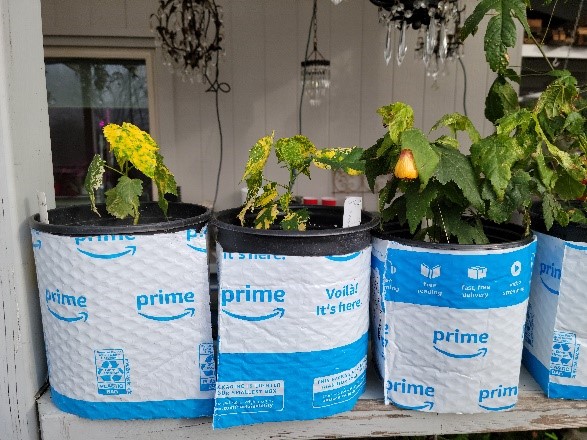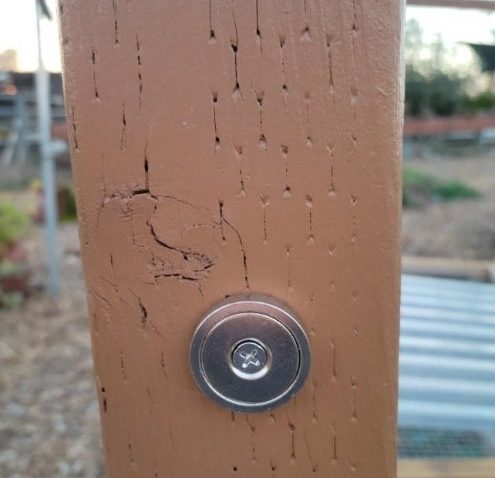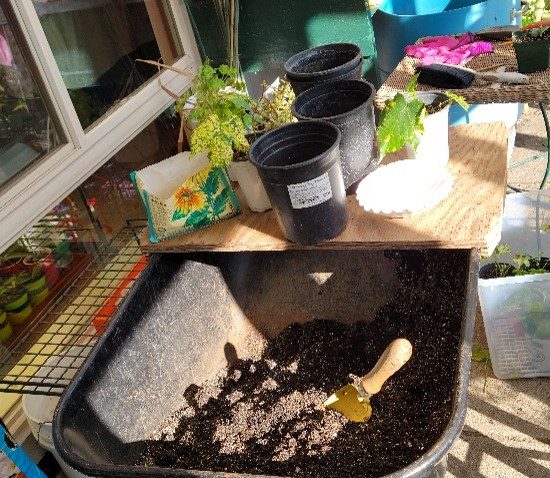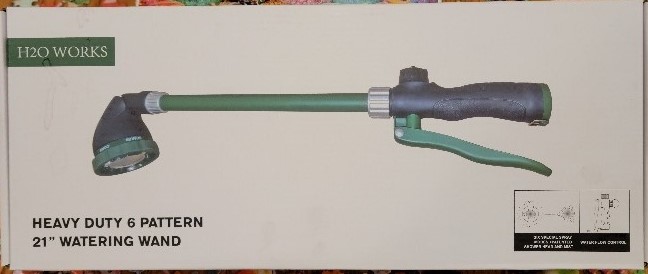
by Stan Logan | Feb 18, 2022 | Container plants, Irrigation
| Growing plants in those ubiquitous black gallon pots can pose a problem. Some plants prefer full sun exposure. However, intense sun rays are absorbed by the black plastic surface and converted into heat. When the planting soil within get hot, root damage results. One solution to this dilemma is to line the insides with bubble wrap. A much easier solution is to shield the outside. I have found the perfect heat barrier. Amazon sends a lot of its items in white bubble wrap pouches. The most common size they use fits around a gallon pot perfectly. If you cut the bottom off and cut the height in half to about 6 ½ inches, you will create tubes that will easily enclose two pots, keeping them cool, and yet allowing the full exposure of the sun to your happy plants. This technique creates a reusable shield that will postpone recycling and most certainly prevent deposit in the local landfill. If you are receiving Amazon Prime delivery pouches and have no use for them, we could certainly use them. LaVille, for instance, transferred 30 abutilons into gallon pots today. However, LaVille says I can’t order more stuff from Amazon just to get more bags.
Stan, The Reusing Man
P.S. I measured the temperature of the soil 1 inch from the edge of a shielded and an unshielded pot today at 3 PM. Shielded – 74 degrees Unshielded – 94 degrees. These are the results at the end of January. Imagine the results in August!
P.P.S. If the sight of all the advertising bothers you, turn the tubes inside out, but I’m not sure the shields will be as effective. I’ll test that out tomorrow and send you another email if there is significant difference. |
 Bubble-wrapped pots |
| |
|

by Stan Logan | Feb 18, 2022 | Garden tools
 Figure 1 – Repaired Aluminum Wand |
 Figure 2 – Failed Leak Repair |
 Figure 3 – Successful Leak Repair |
Have you ever had a problem that you were unable to solve? . . . Don’t you lie to me! Of course, that has happened. Although failure can be frustrating and disappointing, I think it’s a healthy option to simply accept the fact that you cannot succeed at everything you attempt. That scenario occurred recently when a leak appeared in the coiled hose that LaVille loves. (Not my sentiments, by the way.)
Since I had had success stopping the leak in an aluminum spray wand using epoxy (Fig. 1), I tried the same technique on her hose spreading an ample amount of epoxy over the area before taping. I was so sure it would work that I laid out the materials to be included in the photo (Fig. 2) for your information. I use JB Weld Epoxy so frequently that I just leave it out on my work bench.
Note in the photo that I mix the epoxy on a sticky pad with a toothpick and then simply tear off a sheet the next time I do a repair. Good idea, huh? Anyway, since both the electricians’ tape and epoxy were flexible, I thought the mend would work. Nope. Well, I thought a perfectly acceptable option would be to simply buy another hose, but when I attempted to uncouple the hose, it was really frozen at a union with mineral deposits. So, after that failure, I attacked the leak again with a tightly wrapped strip of bicycle inner tubing and a hose clamp (Fig. 3). The fix was a success this time, but only after failures.
I guess I’m sending a mixed message. I was willing to accept failure and go buy another hose, but the failure to be able to do that forced me to fight on until success was reached. In any case, I encourage you to think about using JB Weld for your repairs. and do your mixing on a sticky pad. But whatever problem you attempt to solve, be willing to accept failure as an option.
Stan, The Sometimes-Failing Man

by Stan Logan | Feb 17, 2022 | Garden tools
Yes, gardening friends, it’s time once again for another mystery tool contest. This tool comes courtesy again from Ruth Ostroff. (Do you remember her outstanding worm scraping tool?) This time you must guess the purpose of the round object attached to the painted post in the photo below. Once again, the person who emails me the correct guess first will be the winner. If no correct guess appears, I will reward the person who is most creative in her (or his) response. The winner will receive information as to how to buy this device.
The bonus challenge this month is to tell me the TV program that features a Mystery House in each episode.
And Beverly is disqualified for this contest since she clued us in to this series. Sorry Bev.
Ready. Set. Go!
Stan, The Mystery Man

Mystery Tool
GIVE UP? Click here to see this mystery tool in action.

by Stan Logan | Jan 26, 2022 | Container plants, Garden tools
Here is an addition to your potting shed that is not new, but one that is new to us. LaVille was complaining about a sore back after working for long periods of time repotting plants. She was having to bend down into the blue half barrel that you can see in the upper part of the photo to scoop up potting mix. I turned our wheelbarrow, which is seldom used, into a potting station by cutting an old piece of plywood into a work surface and adding cleats to keep it in place atop the wheel barrow handles. Now LaVille can sit on a medium height stool and do her potting without bending over.

Wood tops wheelbarrow handles to form surface for potting plants.
The potting soil is a mixture of RediGro potting soil, perlite, vermiculite, and worm castings. Note the trowel that I have painted yellow (I hope you know why.) and the bag of Sure Start (which I have yet to discuss). The white coffee filters are to block the holes in the bottoms of the pots. The plants coming out of the quart white pots are variegated abutilons—my favorites.
I was surprised to find that we only have about 20 empty gallon pots remining. I never thought we would come close to using up the supply that I gleaned from the returned stack at Redwood Barn Nursery. I counted up the number of potted gallon pots around the yard and came up with 145.
If you would like your own portable propagation potting station, email me the greatest width of your wheelbarrow and I will cut you a work surface that will make this garden chore even more enjoyable.
Stan, The Tool Man

by Stan Logan | Jan 15, 2022 | Container plants, Garden tools, Irrigation
You know, it’s not easy coming up with a new tool to write about, but I am really excited about this one. As soon as I saw LaVille use it, I just knew there must be at least two other gardeners out there who would appreciate this one. If you are like my wife, she uses a watering wand almost daily. You see, she has probably around 100 potted plants that are under cover outside that don’t get the benefit of rain showers. So even in the winter, a watering wand is used regularly. The last wand was good—until it wasn’t. A crack appeared in the side of the aluminum shaft that caused LaVille to get sprayed along with the plants. I found that applying J-B Weld epoxy to the area, and wrapping with electrician’s tape sealed the leak. LaVille was still unhappy because . . . well, the wand was too long, the control valve was sticking, and the spray was irregular.
So I went to Amazon and ordered what you see below. This, in her opinion, is the perfect watering wand. Adjustable sprays, adjustable head direction, full and fine spray, and a short handle which can still reach higher up hanging plants and water a potted plant held in the other hand. (The full spray is emitted from around 200 minute holes!)
If you cannot read the description from the photo, I am talking about “H2O heavy duty 21 inch Watering Wand” from Amazon.

Happy watering,
Stan, The Tool Man








